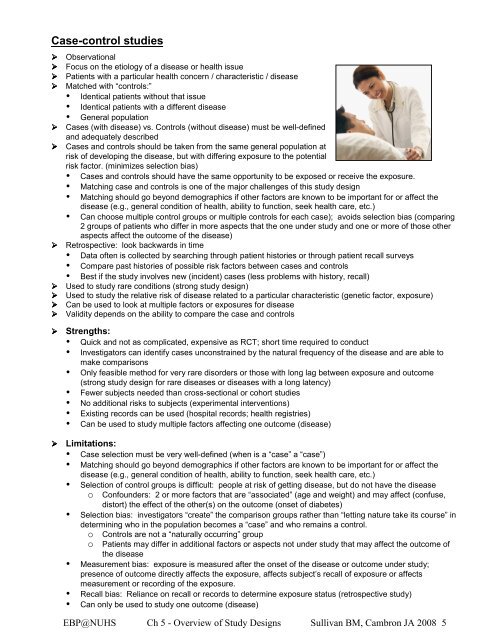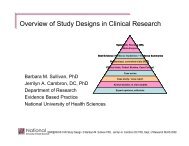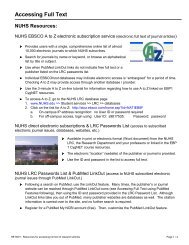Appraising the Literature Overview of Study Designs
Appraising the Literature Overview of Study Designs
Appraising the Literature Overview of Study Designs
Create successful ePaper yourself
Turn your PDF publications into a flip-book with our unique Google optimized e-Paper software.
Case-control studies<br />
Observational<br />
Focus on <strong>the</strong> etiology <strong>of</strong> a disease or health issue<br />
Patients with a particular health concern / characteristic / disease<br />
Matched with “controls:”<br />
Identical patients without that issue<br />
Identical patients with a different disease<br />
<br />
<br />
General population<br />
Cases (with disease) vs. Controls (without disease) must be well-defined<br />
and adequately described<br />
Cases and controls should be taken from <strong>the</strong> same general population at<br />
risk <strong>of</strong> developing <strong>the</strong> disease, but with differing exposure to <strong>the</strong> potential<br />
risk factor. (minimizes selection bias)<br />
<br />
<br />
<br />
Cases and controls should have <strong>the</strong> same opportunity to be exposed or receive <strong>the</strong> exposure.<br />
Matching case and controls is one <strong>of</strong> <strong>the</strong> major challenges <strong>of</strong> this study design<br />
Matching should go beyond demographics if o<strong>the</strong>r factors are known to be important for or affect <strong>the</strong><br />
disease (e.g., general condition <strong>of</strong> health, ability to function, seek health care, etc.)<br />
Can choose multiple control groups or multiple controls for each case); avoids selection bias (comparing<br />
2 groups <strong>of</strong> patients who differ in more aspects that <strong>the</strong> one under study and one or more <strong>of</strong> those o<strong>the</strong>r<br />
aspects affect <strong>the</strong> outcome <strong>of</strong> <strong>the</strong> disease)<br />
Retrospective: look backwards in time<br />
Data <strong>of</strong>ten is collected by searching through patient histories or through patient recall surveys<br />
Compare past histories <strong>of</strong> possible risk factors between cases and controls<br />
Best if <strong>the</strong> study involves new (incident) cases (less problems with history, recall)<br />
Used to study rare conditions (strong study design)<br />
Used to study <strong>the</strong> relative risk <strong>of</strong> disease related to a particular characteristic (genetic factor, exposure)<br />
Can be used to look at multiple factors or exposures for disease<br />
Validity depends on <strong>the</strong> ability to compare <strong>the</strong> case and controls<br />
Strengths:<br />
Quick and not as complicated, expensive as RCT; short time required to conduct<br />
Investigators can identify cases unconstrained by <strong>the</strong> natural frequency <strong>of</strong> <strong>the</strong> disease and are able to<br />
make comparisons<br />
Only feasible method for very rare disorders or those with long lag between exposure and outcome<br />
(strong study design for rare diseases or diseases with a long latency)<br />
Fewer subjects needed than cross-sectional or cohort studies<br />
No additional risks to subjects (experimental interventions)<br />
Existing records can be used (hospital records; health registries)<br />
Can be used to study multiple factors affecting one outcome (disease)<br />
Limitations:<br />
Case selection must be very well-defined (when is a “case” a “case”)<br />
Matching should go beyond demographics if o<strong>the</strong>r factors are known to be important for or affect <strong>the</strong><br />
disease (e.g., general condition <strong>of</strong> health, ability to function, seek health care, etc.)<br />
Selection <strong>of</strong> control groups is difficult: people at risk <strong>of</strong> getting disease, but do not have <strong>the</strong> disease<br />
o Confounders: 2 or more factors that are “associated” (age and weight) and may affect (confuse,<br />
distort) <strong>the</strong> effect <strong>of</strong> <strong>the</strong> o<strong>the</strong>r(s) on <strong>the</strong> outcome (onset <strong>of</strong> diabetes)<br />
Selection bias: investigators “create” <strong>the</strong> comparison groups ra<strong>the</strong>r than “letting nature take its course” in<br />
determining who in <strong>the</strong> population becomes a “case” and who remains a control.<br />
o Controls are not a “naturally occurring” group<br />
o Patients may differ in additional factors or aspects not under study that may affect <strong>the</strong> outcome <strong>of</strong><br />
<strong>the</strong> disease<br />
Measurement bias: exposure is measured after <strong>the</strong> onset <strong>of</strong> <strong>the</strong> disease or outcome under study;<br />
presence <strong>of</strong> outcome directly affects <strong>the</strong> exposure, affects subject’s recall <strong>of</strong> exposure or affects<br />
measurement or recording <strong>of</strong> <strong>the</strong> exposure.<br />
Recall bias: Reliance on recall or records to determine exposure status (retrospective study)<br />
Can only be used to study one outcome (disease)<br />
EBP@NUHS Ch 5 - <strong>Overview</strong> <strong>of</strong> <strong>Study</strong> <strong>Designs</strong> Sullivan BM, Cambron JA 2008 5





